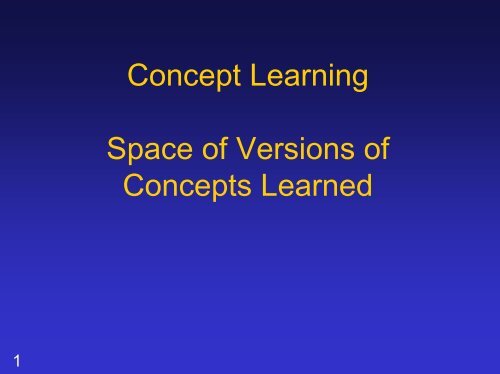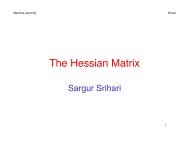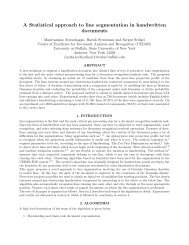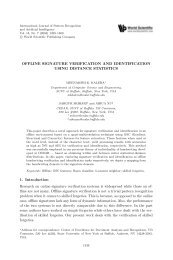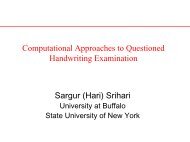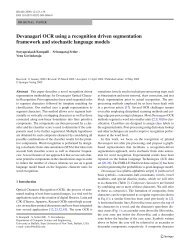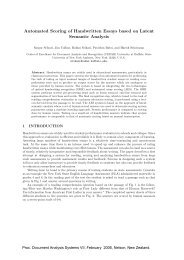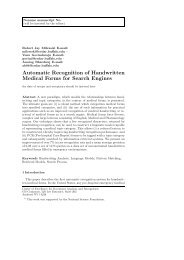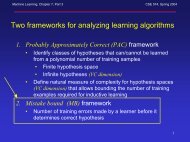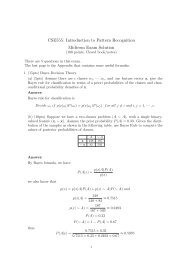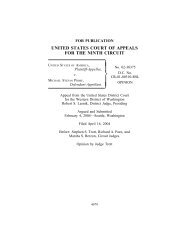Candidate Elimination - CEDAR
Candidate Elimination - CEDAR
Candidate Elimination - CEDAR
Create successful ePaper yourself
Turn your PDF publications into a flip-book with our unique Google optimized e-Paper software.
Concept Learning<br />
Space of Versions of<br />
Concepts Learned<br />
1
A Concept Learning Task<br />
• Target concept:<br />
• “Days on which Aldo enjoys his favorite water sport”<br />
Example Sky AirTemp Humidity Wind Water Forecast EnjoySport<br />
1 Sunny Warm Normal Strong Warm Same Yes<br />
2 Sunny Warm High Strong Warm Same Yes<br />
3 Rainy Cold High Strong Warm Change No<br />
4 Sunny Warm High Strong Cool Change Yes<br />
2<br />
• Task is to learn to predict value of EnjoySport<br />
from three positive examples, one negative<br />
Table 2.1<br />
example
FIND-S Algorithm : Finding a<br />
Maximally Specific Hypothesis<br />
• Initialize h to the most specific hypothesis in H<br />
• For each positive training instance x<br />
• For each attribute constraint a i in h<br />
• If the constraint a i is satisfied by x<br />
• Then do nothing<br />
• Else replace a i in h by the next more general constraint that<br />
is satisfied by x<br />
• Output hypothesis h<br />
3<br />
• Note: Find-S ignores negative training instances<br />
• Since negative instances will be classified as negative by<br />
hypothesis anyhow, as long as samples are not inconsistent
Hypothesis found by FIND-S<br />
• h
Hypothesis Space Search Performed by FIND-S<br />
+:positive instance<br />
-: negative instance<br />
5
Version Space and the <strong>Candidate</strong><br />
<strong>Elimination</strong> Algorithm<br />
• Find-S algorithm outputs a hypothesis that<br />
is consistent with the training samples<br />
• <strong>Candidate</strong> -<strong>Elimination</strong> algorithm outputs<br />
all hypotheses consistent with the training<br />
samples<br />
6
Representation<br />
• The CANDIDATE-ELIMINATION algorithm finds<br />
all describable hypotheses that are<br />
consistent with the observed training<br />
examples.<br />
7
Consistent Hypothesis: Definition<br />
• A hypothesis h is consistent with a set of<br />
training examples D if and only if h(x)=c(x) for<br />
each example in D.<br />
• A hypothesis is consistent with the training<br />
samples if it correctly classifies the samples<br />
Consistent ( h,<br />
D)<br />
≡ ( ∀ x,<br />
c(<br />
x)<br />
∈ D)<br />
h(<br />
x)<br />
= c(<br />
x)<br />
8
Version Space: Definition<br />
• The subset of all hypotheses consistent<br />
with the training examples<br />
• Definition: The version space, VS H,D ,<br />
w.r.t. hypotheses H and examples D, is<br />
a subset of hypotheses from H<br />
consistent with the examples<br />
9<br />
VS<br />
{ h ∈ H | Consistent(<br />
h,<br />
)}<br />
H , D<br />
≡<br />
D
The LIST-THEN-ELIMINATE<br />
Algorithm<br />
• The LIST-THEN-ELIMINATE algorithm first<br />
initializes the version space to contain all<br />
hypotheses in H and then eliminates any<br />
hypothesis found inconsistent with any<br />
training example.<br />
10
The LIST-THEN-ELIMINATE<br />
Algorithm<br />
• VersionSpace ← a list containing every hypothesis<br />
in H<br />
• For each training example, <br />
• remove from VersionSpace any hypothesis h for<br />
which h(x)≠c(x).<br />
• Output the list of hypotheses in VersionSpace.<br />
• Requires exhaustively enumerating all hypotheses<br />
in H -- unrealistic for all but most trivial hypothesis<br />
spaces<br />
11
A More Compact Representation for<br />
Version Spaces<br />
• The CANDIDATE-ELIMINATION algorithm<br />
• same principle as LIST-THEN-ELIMINATE<br />
algorithm<br />
• employs a more compact representation of<br />
the version space than does the LIST-THEN-<br />
ELIMINATE algorithm<br />
• version space is represented by its most<br />
general and least general members<br />
12
Version Space with General (G) and<br />
Specific (S) Boundary Sets<br />
13
General Boundary<br />
Definition: The general boundary G, with<br />
respect to hypothesis space H and training<br />
data D, is the set of maximally general<br />
members of H consistent with D.<br />
G ≡ { g ∈ H | Consistent(<br />
g,<br />
D)<br />
∧ ( ¬∃g′∈<br />
H )[( g′<br />
><br />
g<br />
g)<br />
∧ Consistent(<br />
g′<br />
, D)]}<br />
}<br />
14
Specific Boundary<br />
Definition: The specific boundary S, with<br />
respect to hypothesis space H and training<br />
data D, is the set of minimally general (i.e.,<br />
maximally specific) members of H consistent<br />
with D.<br />
S ≡ { s ∈ H | Consistent(<br />
s,<br />
D)<br />
∧ ( ¬∃s′∈<br />
H )[( s > s′<br />
g<br />
) ∧ Consistent(<br />
s′<br />
, D)]}<br />
}<br />
15
16<br />
Version Space Theorem<br />
Version space consists of hypotheses<br />
contained in S, plus those contained in G and<br />
those in-between<br />
Theorem: Let X be an arbitrary set of instances,<br />
and let H be a set of boolean-valued<br />
hypotheses defined over X. Let c : X → {0,1} be<br />
an arbitrary target concept defined over X, and<br />
let D be an arbitrary set of training examples<br />
{〈x,c(x)〉}. For all X, H, c, and D such that S and<br />
G are well defined,<br />
VS<br />
H<br />
, D<br />
= { h ∈ H | ( ∃s<br />
∈ S)(<br />
∃g<br />
∈G)(<br />
g ≥<br />
g<br />
h ≥<br />
g<br />
s)}
The CANDIDATE-ELIMINATION Algorithm<br />
• The CANDIDATE-ELIMINATION algorithm<br />
computes the version space containing all<br />
hypotheses from H that are consistent with<br />
an observed sequence of training<br />
examples.<br />
17
CANDIDATE-ELIMINATION Algorithm<br />
Initialize G to the set of maximally general hypotheses in H<br />
Initialize S to the set of maximally specific hypotheses in H<br />
For each training example d, do<br />
• If d is a positive example<br />
18<br />
• Remove from G any hypothesis inconsistent with d<br />
• For each hypothesis s in S that is not consistent with d<br />
• Remove s from S<br />
• Add to S all minimal generalizations h of s such that<br />
• h is consistent with d, and some member of G is more general than h<br />
• Remove from S any hypothesis that is more general than another<br />
hypothesis in S<br />
• If d is a negative example<br />
• Remove from S any hypothesis inconsistent with d<br />
• For each hypothesis g in G that is not consistent with d<br />
• Remove g from G<br />
• Add to G all minimal specializations of h of g such that<br />
• h is consistent with d, and some member of S is more specific than h<br />
• Remove from G any hypothesis that is less general than another<br />
hypothesis in G
An Illustrative Example<br />
• We will trace the CANDIDATE-ELIMINATION<br />
algorithm with training examples below.<br />
Example Sky AirTemp Humidity Wind Water Forecast EnjoySport<br />
1 Sunny Warm Normal Strong Warm Same Yes<br />
2 Sunny Warm High Strong Warm Same Yes<br />
3 Rainy Cold High Strong Warm Change No<br />
4 Sunny Warm High Strong Cool Change Yes<br />
19
CANDIDATE-ELIMINATION Trace (Samples 1 and 2)<br />
Samples 1 and 2 force S boundary to become more general. They<br />
have no effect on G boundary<br />
S 0<br />
: {}<br />
S 1<br />
: {}<br />
S 2<br />
: {}<br />
G 0<br />
,G 1<br />
,G 2<br />
: {}<br />
Training examples:<br />
1. < Sunny, Warm, Normal, Strong, Warm, Same>, Enjoy Sport = Yes<br />
2. < Sunny, Warm, High, Strong, Warm, Same>, Enjoy Sport = Yes<br />
20
CANDIDATE-ELIMINATION Trace (Sample 3)<br />
Negative example forces G 2 to be specialized to G 3<br />
S 2<br />
,S 3<br />
: {}<br />
G 3<br />
: { }<br />
G 2<br />
: {}<br />
Only 3 new hypotheses are included. For instance h= is inconsistent with<br />
previous positive training samples.. h is not more general than S2<br />
Training example:<br />
3. < Rainy, Cold, High, Strong, Warm, Change>, Enjoy Sport = No<br />
21
CANDIDATE-ELIMINATION Trace (Sample 4)<br />
Positive sample generalizes S boundary<br />
S 3<br />
: {}<br />
S 4<br />
: {}<br />
G 4<br />
: {< Sunny, , , , , > }<br />
G 3<br />
: { }<br />
Removes one member of the G boundary because it does not cover the new<br />
example<br />
Training example:<br />
4. < Sunny, Warm, High, Strong, Cool, Change>, Enjoy Sport = Yes<br />
22
Final Version Space for EnjoySport<br />
S 4<br />
: {}<br />
<br />
G 4<br />
: { }<br />
23
Result of <strong>Candidate</strong> <strong>Elimination</strong> Algorithm<br />
• S4: <br />
• G4:,<br />
Example Sky AirTemp Humidity Wind Water Forecast EnjoySport<br />
1 Sunny Warm Normal Strong Warm Same Yes<br />
2 Sunny Warm High Strong Warm Same Yes<br />
3 Rainy Cold High Strong Warm Change No<br />
4 Sunny Warm High Strong Cool Change Yes<br />
Table 2.1<br />
24
25<br />
Remarks on Version Spaces and<br />
CANDIDATE-ELIMINATION
Will CANDIDATE-ELIMINATION Algorithm<br />
Converge to the Correct Hypothesis<br />
• The version space learned by the<br />
CANDIDATE-ELIMINATION will converge<br />
toward the hypothesis that correctly<br />
describes the target concept, provided that<br />
• there are no errors in the training examples<br />
• there is some hypothesis in H that correctly<br />
describes the target concept.<br />
26
What Training Example Should the<br />
Learner Request Next<br />
• If learner is allowed to conduct experiments in<br />
which it chooses the next instance, then obtains<br />
correct classification of instance from an<br />
external oracle (eg, nature or teacher).<br />
Example Sky AirTemp Humidity Wind Water Forecast EnjoySport<br />
1 Sunny Warm Normal Strong Warm Same Yes<br />
2 Sunny Warm High Strong Warm Same Yes<br />
3 Rainy Cold High Strong Warm Change No<br />
4 Sunny Warm High Strong Cool Change Yes<br />
• Consider Version Space learned<br />
27
Training Example Requested by Learner<br />
• Choose an instance classified as positive by some,<br />
negative by others<br />
28<br />
•<br />
• one such instance:
Optimal query strategy<br />
• The optimal query strategy for a concept learner<br />
• generate instances that satisfy exactly half of the<br />
hypotheses in the current version space.<br />
• When this is possible, size of the version space is reduced by<br />
half with each example<br />
• correct target concept found with log 2 |VS| experiments<br />
• Analogous to playing 20 questions in which goal is to ask yes-no<br />
questions to determine correct hypothesis<br />
• optimal strategy is to ask questions that evenly split<br />
candidate hypotheses into sets that predict yes and no<br />
• In general, a larger number of queries required<br />
29
How Can Partially Learned Concepts Be Used<br />
• Even if the target concept has not yet<br />
been fully learned (version space contains<br />
multiple hypotheses), it is possible to<br />
classify certain examples with the same<br />
degree of confidence as if the target<br />
concept had been uniquely identified<br />
30
New Instances To Be Classified<br />
Instance Sky AirTemp Humidity Wind Water Forecast EnjoySport<br />
A Sunny Warm Normal Strong Cool Change <br />
B Rainy Cold Normal Light Warm Same <br />
C Sunny Warm Normal Light Warm Same <br />
D Sunny Cold Normal Strong Warm Same <br />
• A: classified as positive by every hypothesis<br />
• Note: if instance satisifies some member of S, then every other<br />
member of VS, which are at least as general as S, are satisfied<br />
• B: classified as negative by every hypothesis<br />
• instance satisfies no member of G<br />
• C: half of hypotheses classify it as positive, other half as negative<br />
• D: 2 as positive, 6 as negative, proportion can be interpreted as<br />
probability of classification<br />
31
Inductive Bias<br />
32<br />
• Fundamental questions for inductive inference in<br />
general<br />
• What if the the target concept is not contained in the<br />
hypothesis space<br />
• Can we avoid this difficulty by using a hypothesis<br />
space that includes every possible hypothesis<br />
• How does the size of the hypothesis space influence<br />
the ability of the algorithm to generalize the<br />
unobserved instances<br />
• How does the size of the hypothesis space influence<br />
the number of training examples that must be<br />
observed
A Biased Hypothesis Space<br />
Example Sky AirTemp Humidity Wind Water Forecast EnjoySport<br />
1 Sunny Warm Normal Strong Cool Change Yes<br />
2 Cloudy Warm Normal Strong Cool Change Yes<br />
3 Rainy Warm Normal Strong Cool Change No<br />
There are no hypotheses consistent with the<br />
samples<br />
• Need a more expressive hypothesis space<br />
S 2<br />
: <br />
33
An Unbiased Learner<br />
• The obvious solution to the problem of assuring<br />
that they target concept is in the hypothesis<br />
space H is to provide a hypothesis space<br />
capable of representing every teachable<br />
concept; that is, it is capable of representing<br />
every possible subset of the instances X.<br />
• In general, the set of all subsets of a set X is<br />
called the power set of X.<br />
34
An Unbiased Learner<br />
• EnjoySport has instance space size of<br />
3.2.2.2.2.2=96<br />
• Number of concepts teachable is 2 96 =10 28<br />
• Conjunctive hypothesis space has only 973 =<br />
(1+4.3.3.3.3.3) concepts, which is very biased!<br />
• Analogous to Number of functions of n binary<br />
variables is<br />
2 k where k=2 n<br />
35
Truth Table(s) for 3 binary variables<br />
a 1 a 2 a 3 h 0 h 1 h 2 h 3 … h 255<br />
0 0 0 0 1 0 1 1<br />
0 0 1 0 0 1 1 1<br />
0 1 0 0 0 0 0 1<br />
0 1 1 0 0 0 0 1<br />
1 0 0 0 0 0 0 1<br />
1 0 1 0 0 0 0 1<br />
1 1 0 0 0 0 0 1<br />
1 1 1 0 0 0 0 1<br />
Number of instances = 8<br />
Number of Teachable concepts = 256<br />
36
Conjunctive concepts for 3 binary<br />
variables<br />
Number of Conjunctive concepts = 1 + 3.3.3 = 28<br />
conjunctive concepts:<br />
0, 1,<br />
a 1 , a 1 , a 2 , a 2 , a 3 , a 3 ,<br />
a 1 a 2 , a 1 a 2 , a 1 a 3 , a 1 a 3 , a 3 a 2 , a 3 a 2 ,<br />
a 1 a 2 , a 1 a 2 , a 1 a 3 , a 1 a 3 , a 3 a 2 , a 3 a 2 ,<br />
a 1 a 2 a 3 , a 1 a 2 a 3 , a 1 a 2 a 3 , a 1 a 2 a 3 ,<br />
a 1 a 2 a 3 , a 1 a 2 a 3 , a 1 a 2 a 3 , a 1 a 2 a 3 ,<br />
37
An Unbiased learner<br />
• New Hypothesis space H`<br />
• Allow disjunctions, conjunctions and<br />
negations<br />
• Sky=Sunny or Sky=Cloudy can be<br />
represented as:<br />
• v <br />
38
An Unbiased Learner<br />
• New hypothesis space allows target concepts to<br />
be represented<br />
• However, very expressive hypothesis<br />
representation cannot generalize beyond<br />
observed samples<br />
• Example:<br />
• three positive examples (x1,x2,x3),<br />
• where xi are feature vectors<br />
• two negative examples (x4,x5),<br />
S={x 1 v x 2 v x 3 }, disjunction of positive samples<br />
39<br />
G={~( x 4 v x 5 )}, negated disjunction of negative<br />
samples
Unbiased Learner is Too Limited<br />
• S boundary is always disjunction of positive<br />
examples<br />
• G boundary is always disjunction of negative<br />
examples<br />
• No generalization: only examples<br />
unambiguously classified by S and G are the<br />
training examples themselves<br />
• Every single instance of X has to be presented!<br />
40
The Futility of Bias-Free Learning<br />
• Fundamental property of inductive<br />
inference: A learner that makes no a priori<br />
assumptions regarding the identity for the<br />
target concept has no rational basis for<br />
classifying any unseen instances.<br />
• Inductive learning requires some form of<br />
prior assumptions or inductive bias.<br />
41
Inductive Bias of a Learner<br />
Set of additional assumptions B sufficient<br />
to justify its inductive inferences as<br />
deductive inferences<br />
42
Inductive Bias Definition<br />
43<br />
•Concept learning algorithm L for instances X.<br />
•Let<br />
• c be a concept defined over X<br />
• D c ={〈x,c(x)〉} be an arbitrary set of training<br />
examples of c.<br />
• L(x i ,D c ) denote the classification assigned to<br />
instance x i by L after training on data D.<br />
•Inductive bias of L is any minimal set of<br />
assertions B such that for any target concept c<br />
and corresponding training examples D c<br />
( ∀xi<br />
∈ X )[( B ∧ Dc<br />
∧ xi<br />
) | − L(<br />
xi<br />
, Dc<br />
)]
CANDIDATE-ELIMINATION Algorithm<br />
inductive bias<br />
Inductive bias of CANDIDATE-ELIMINATION<br />
Algorithm: The target concept c is contained<br />
in the given hypothesis space H.<br />
44
Modeling Inductive Systems by Equivalent<br />
Deductive Systems<br />
Figure 2. 8<br />
45
Three Learners :<br />
weakest to strongest bias<br />
• Rote Learner<br />
• store each sample in memory; otherwise reject<br />
• CANDIDATE-ELIMINATION Algorithm<br />
• new instances classified only where all members of<br />
the current version space agree on classification;<br />
otherwise reject<br />
• FIND-S<br />
• find most specific hypothesis consistent with samples;<br />
bias: all instances are negative instances unless the<br />
opposite is entailed by its other knowledge<br />
46
Summary<br />
• Concept learning can be cast as a problem of<br />
searching through a large predefined space of<br />
potential hypotheses<br />
• The general-to-specific partial ordering of<br />
hypotheses is be useful for ordering the search.<br />
• The FIND-S algorithm utilizes the general-tospecific<br />
ordering to find the most specific<br />
hypothesis.<br />
• The CANDIDATE-ELIMINATION utilizes the general-tospecific<br />
ordering to compute the version space.<br />
47
Summary, continued<br />
48<br />
• The S and G sets provide the learner with a<br />
description of the uncertainty regarding the<br />
exact identity of the target concept.<br />
• Version spaces and the CANDIDATE-ELIMINATION<br />
algorithm provide a useful conceptual framework<br />
for studying concept learning.<br />
• Inductive learning algorithms are able to classify<br />
unseen examples only because of their implicit<br />
inductive bias for selecting one consistent<br />
hypothesis over another.
Summary, continued<br />
• If the hypothesis space is enriched to the<br />
point where there is a hypothesis<br />
corresponding to every possible subset of<br />
instances, this will remove any inductive<br />
bias from the CANDIDATE-ELIMINATION<br />
algorithm.<br />
49


